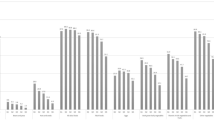Abstract
Maize is a cereal particularly lacking in tryptophan, which is the precursor of serotonin, an important neurotransmitter. Altough complementary foods may eliminate tryptophan deficiency, serotonin deficiency may often continue to exist because of competition made by other Large Neutral Amino Acids (LNAA) against tryptophan for neuron access, since they use the same carrier to cross the blood-brain barrier. Thus serotonin synthesis depends on two variables: the amount of tryptophan and the trp/LNAA ratio (R). “R” is lowest for common maize, low for beans and, as a rule, for most vegetable foods, higher for meat. So, when maize is the preponderant food in the meal, the “R” value lowers and so in parallel serotonin synthesis does. Serotonin deficiency involves several behavioural consequences, such as the tendency towards aggressive behaviour or the religious fanaticism. Among native american populations, these consequences appear, as a rule, positively correlated with maize alimentary dependence (Aztecs appear as those who greatly suffered from serotonin deficiency). In the world these are thinkable for some african populations (i.e. Zulu) or european (i.e. Balkan peoples).
Similar content being viewed by others
Bibliography
Carruba M., Picotti G.B., Genovese E., Mantegazza P., 1977.Stimulatory effect of a maize diet on sexual behavior of male rats. Life Sciences, 20: 159–163.
De Voto B., 1952. The Course of Empire. Boston: Houghton Mifflin Co..
Ernandes M. & Giammanco S., 1992.A serotonin deficiency hypothesis explaining the aztec human sacrifice/cannibalism complex. Antropologia contemporanea, 15 (2): 65–73.
Farb P., 1968. Man’s Rise to Civilization as Shown by the Indians of North America from Primeval Times to the Coming of the Industrial State.
Fernstrom J.D., Wurtman R.J., 1972.Brain serotonin content: physiological regulation by plasma neutral amino acids. Science, 178: 414–416.
Garretson M. S., 1939. The American Bison.
Gessa G.L., Tagliamonte A., 1974.Role of brain monoamines in male sexual behavior. Life Sciences, 14(3):425–436.
Giammanco S., Emandes M., Lopez de Oñate R., Paderni M. A., 1990.Short term diet of precooked corn meal almost lacking in tryptophan and intraspecific rat-mouse aggressive behaviour. Archives Internationales de Physiologie et de Biochimie, 98: 23–26.
Harner M., 1977.The ecological basis for Aztec sacrifice. American Ethnologist, 4: 117–135.
Harris M., 1977. Cannibals and kings. The origins of cultures. New York: Random House.
Izquierdo J.A., Rabiller G., Costas S.M., Justel E.A., Savini C.V., 1979.Effect on rats and mice of a diet with low tryptophan content (maize flour). Acta Physiologica Latino-americana, 29: 239–243.
Katz S. H., Hediger M. L., Valleroy L. A., 1974.Traditional Maize Processing Techniques in the New World. Science, 184: 765–773.
Krickeberg W., 1959. Altmexikanische Kulturen. Berlin: Safari-Verlag C. Boldt und R. Jaspert.
La Farge O., 1960. A pictorial History of the American Indian. La Farge et Colden Press Inc.
MacLean P.D., 1978. A mind of three minds: educating the triune brain. Chicago: University of Chicago Press.
Mandell A.J., 1980. Toward a psychobiology of transcendence: God in the brain. In (Davidson & Davidson ed), The psychobiology of consciousness, pp. 379–464. New York: Plenum Press.
Martinez M., 1936. Plantas utiles de Mexico, 2a edicion. Mexico: Edicones Botas.
Mawson A.R., Jacobs K.M., 1978.Corn consumption, tryptophan, and cross-national homicide rates. J. of Orthomolecular Psychiatry, 7 (4): 227–230.
Murdock G.P., 1967. Ethnographic Atlas. Pittsburgh: University Press.
Ortiz de Montellano B.R., 1978.Aztec cannibalism: an ecological necessity? Science, 200: 611–617.
Peters C.M., Pardo-Tejeda E., 1982.Brosimum alicastrum (Moraceae): uses and potential in Mexico. Economic Botany, 36 (2): 166–175.
Rapoport J.L., 1989.The biology of obsessions and compulsions. Scientific American, 260 (3): 62–69.
Ritter E. A., 1978: Shaka Zulu. New York: Penguin Books.
Sahagùn B. de, 1951 (or. 1558-69): General history of the things of New Spain: Florentine Codex. Book 2-The ceremonies. (A.J.O. Anderson and C.E. Dibble trans. from the Aztec). Santa Fe and Salt Lake City: New Mexico School of American Research and University of Utah.
Sanchez-Marroquin A., del Valle F.R., Escobedo M., Avitia R., Maya S., Vega M., 1986.Evaluation of whole amaranth (Amaranthus cruentus) for infant formulas. J. of Food Sciences, 51 (5): 1231–1234.
Stirling M.W., 1955. Indians of the Americas. Washington: National Geographic Society.
Unwin M. C., 1934. Sex and Culture. London: Oxford Un. Press, H. Millford.
Vaillant G.C., 1941. Aztecs of México. New York: Doubleday and C.
Vlora A.K., 1956.Sintesi di una geografia del mais. L’universo, 2: 285–297 (I) and 617–624 (II).
Watts A. 1970. Does it matter? Essay on man’s relation to materiality. New York: Pantheon Books.
Author information
Authors and Affiliations
Rights and permissions
About this article
Cite this article
Ernandes, M., La Guardia, M. & Giammanco, S. Maize based diets and possible neurobehavioural after-effects among some populations in the world. Hum. Evol. 11, 67–77 (1996). https://doi.org/10.1007/BF02456990
Issue Date:
DOI: https://doi.org/10.1007/BF02456990




